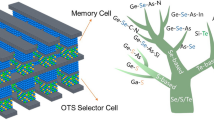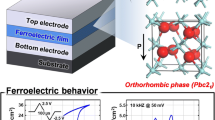Abstract
In this rapidly growing and changing world of electronics industry it is very critical to have precise model and simulation for device. This paper presents the work on simulating the performance of thin film transistors (TFT) structure with different high K dielectric materials and source drain materials. TFT structure plays an important role in the TFT performance and this paper compares the ID–VD and ID–VG, threshold voltage (VT), subthreshold swing and on and off current (Ion/Ioff) of the TFT. Further, for a bottom gate staggered configuration, the effect of different materials as Source and Drain as well as the effect of dielectric strength on the tunneling layer of the TFT is studied to evaluate its suitability for applications like non-volatile memory. The effect of temperature on different performance characteristics of the bottom gate TFT structure like threshold voltage, sub-threshold swing, on–off current ratio are also analysed.













Similar content being viewed by others
References
S. Jiazhen, J. Hyun-Jun, H. Ki-Lim, H. TaeHyun, P. Jin-Seong, Review of recent advances in flexible oxide semiconductor thin-film transistors. J. Inf. Disp. 18(4), 159–172 (2017). https://doi.org/10.1080/15980316.2017.1385544
K. Mukhopadhyaya, P. Srividya, Trends in performance characteristics and modelling of oxide based TFT. Mater. Today: Proc. 55, 414–418 (2022). https://doi.org/10.1016/j.matpr.2021.12.596
K. Mukhopadhyaya, P. Srividya, Challenges in p-type oxide based thin film transistor. IOP Conf. Ser.: Mater. Sci. Eng. 1012, 012055–012064 (2021). https://doi.org/10.1088/1757-899X/1012/1/012055
H. Min-Feng, W. Yung-Chun, C. Jiun-Jye, L. Kuei-Shu, Twin thin-film transistor nonvolatile memory with an indium–gallium–zinc–oxide floating gate. IEEE Electron Device Lett. 34, 75–77 (2013). https://doi.org/10.1109/LED.2012.2226232
H. Yin, S. Kim, C.J. Kim, I. Song, J. Park, S. Kim, Y. Park, Fully transparent nonvolatile memory employing amorphous oxides as charge trap and transistor’s channel layer. Appl. Phys. Lett. 93, 1–3 (2008). https://doi.org/10.1063/1.3012386
A. Suresh, S. Novak, P. Wellenius, V. Misha, J.F. Muth, Transparent indium gallium zinc oxide transistor based floating gate memory with platinum nanoparticles in the gate dielectric. Appl. Phys. Lett. 94, 1–3 (2009). https://doi.org/10.1063/1.3106629
W. Zhang, L. Renrong, L. Libin, Y. Guofang, W. Jing, X. Jun, R. Tian-Ling, Demonstration of a-InGaZnO TFT nonvolatile memory using TiAlO charge trapping layer. IEEE Trans. Nanotechnol. 17, 1089–1093 (2018). https://doi.org/10.1109/TNANO.2018.2810885
N. Choi, H.J. Kang, M. Joe, G. Park, H. Lee, Reconfigurable cell string having FET and super-steep switching diode operation in 3D NAND flash memory, in IEEE 2nd Electron Devices Technology and Manufacturing Conference (EDTM) (IEEE, 2018), pp. 220−222. https://doi.org/10.1109/EDTM.2018.8421436
H. Ohshima, 8.1: Invited paper: value of LTPS: present and future, in SID Symposium Digest of Technical Papers, Wiley Online Library, 45 (2014), pp. 75−78.https://doi.org/10.1002/j.2168-0159.2014.tb00021.x
H.J. Bang, N.C. Nguyen, D.H. Lee, A.H.T. Nguyen, S. Kang, J.W. Choi, S.Y. Han, R. Choi, Effect of high-pressure hydrogen or deuterium anneal on polysilicon channel field effect transistors. J. Nanosci. Nanotechnol. 16, 10341–10345 (2016). https://doi.org/10.1166/jnn.2016.13156
Z. Hon, J. Yao, Z. Wu, H. Yin, Simulation for the feasibility of high-mobility channel in 3D NAND memory, in China Semiconductor Technology International Conference (CSTIC) (IEEE, 2018), pp. 1−3. https://doi.org/10.1109/CSTIC.2018.8369198
R. Singh, M. Khosla, I. Saini, N. Kumar, Design and analysis of IGZO based junction less thin film transistor using SOI technology. SILICON 13, 2309–2318 (2020). https://doi.org/10.1007/s12633-020-00803-9
S. Mondal, V. Venkataraman, Flash memory TFT based on fully solution processed oxide, in 75th Annual Device Research Conference (DRC) (IEEE, 2017), pp. 1–2. https://doi.org/10.1109/DRC.2017.7999508
L.Y. Su, H.Y. Lin, H.K. Lin, S.L. Wang, L.H. Peng, J. Huang, Characterizations of amorphous IGZO thin-film transistors with low subthreshold swing. IEEE Electron Device Lett. 32(9), 1245–1247 (2011). https://doi.org/10.1109/LED.2011.2160931
H.H. Hsieh, T. Kamiya, K. Nomura, H. Hosono, C. Wu, Modeling of amorphous InGaZnO4 thin film transistors and their subgap density of states. Appl. Phys. Lett. 92(13), 133503–133506 (2008). https://doi.org/10.1063/1.2857463
B. Iniguez, L. Wang, A. Fjeldly, M.S. Shur, H. Slade, Thermal, self-heating and kink effects in a-Si:H thin film transistors, in IEDM Technical Digest (2002), pp. 879–882. https://doi.org/10.1109/IEDM.1998.746495
A. Kuo, T.K. Won, J. Kanicki, Advanced amorphous silicon thin-film transistors for AM-OLEDs: electrical performance and stability. IEEE Trans. Electron. Dev. 55, 1621–1629 (2008). https://doi.org/10.1109/TED.2008.924047
P.G. LeComber, W.E. Spear, Electronic transport in amorphous silicon films. Phys. Rev. Lett. 25, 509–511 (1970). https://doi.org/10.1103/PhysRevLett.25.509
S. Lee, J. Oh, S. Yang, H. Yun, K. Jeong, H. Lee, G. Le, Characterization of polycrystalline silicon-oxide-nitride-oxide-silicon devices on a SiO2 or Si3N4 buffer layer. Electron. Mater. Lett. 9, 23–27 (2013). https://doi.org/10.1007/s13391-013-3176-1
Y. Li, Y. Pei, R. Hu, Z. Chen, Y. Ni, J. Lin, Y. Chen, X. Zhang, Z. Shen, J. Liang, B. Fan, G. Wang, H. Duan, Charge trapping memory characteristics of amorphous-indium–gallium–zinc oxide thin-film transistors with defect engineered alumina dielectric. IEEE Trans. Electron. Dev. 62, 1184–1188 (2015). https://doi.org/10.1109/TED.2015.2402220
Y. Kim, G. Lee, Effects of Al2O3 gate insulator on the instability of amorphous indium-gallium zinc oxide thin film transistors. AIP Adv. 8, 085112–085119 (2018). https://doi.org/10.1063/1.5043340
Author information
Authors and Affiliations
Corresponding author
Ethics declarations
Conflict of interest
The authors declare that they have no conflict of interest.
Additional information
Publisher's Note
Springer Nature remains neutral with regard to jurisdictional claims in published maps and institutional affiliations.
Rights and permissions
Springer Nature or its licensor (e.g. a society or other partner) holds exclusive rights to this article under a publishing agreement with the author(s) or other rightsholder(s); author self-archiving of the accepted manuscript version of this article is solely governed by the terms of such publishing agreement and applicable law.
About this article
Cite this article
Mukhopadhyaya, K., Srividya, P. TFT Structure Simulation with Various High K Dielectric Materials for Non-volatile Memory Device. Trans. Electr. Electron. Mater. 25, 255–264 (2024). https://doi.org/10.1007/s42341-023-00502-3
Received:
Revised:
Accepted:
Published:
Issue Date:
DOI: https://doi.org/10.1007/s42341-023-00502-3




